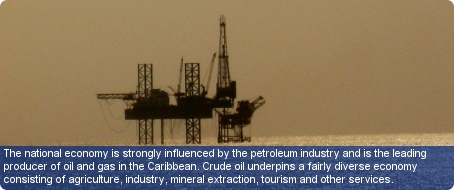Find a business in Trinidad and Tobago

For a state consisting of two small islands, Trinidad and Tobago has a sophisticated economy. Oil, as well as natural gas, has been the dominant commodity in the economy and in 2010 Trinidad and Tobago had a GNI per capita of US$15,380. During 2002-06 the economy grew at 10% per annum due to a rise in oil prices, but growth slowed to 3.3% per annum 2006-10. Trinidad and Tobago is diversifying its economy and the tourism and manufacturing sectors are growing but oil and gas are still the main sources of revenue, as they have been for the last 30 to 40 years.
The two island state is the leading producer of oil and gas in the Caribbean. Crude oil underpins a fairly diverse economy consisting of agriculture, industry, mineral extraction, tourism and other services. Agriculture is not an important part of the economy, contributing only 1% to GDP in 2010.
Trinidad and Tobago’s major exports are crude petroleum, ammonia, methanol, manufactured goods, food and live animals. The country’s main imports are industrial and electrical machinery, manufactured goods, transport equipment and consumer goods.
Growth had been fuelled by investments in liquefied natural gas (LNG), petrochemicals, and steel. Trinidad and Tobago has substantial reserves of oil and gas. There are 728.3 million barrels of proven oil reserves and 408.2 billion cubic metres of proven natural gas reserves (January, 2011 estimate). The increase in the global demand for natural gas usage is on an upward trajectory. World natural gas consumption grew by 3.1% in 2011 according to the BP statistical review of World Energy 2012, and with LNG providing a relatively clean source of energy at competitive prices, this figure is likely to increase. The Government of Trinidad and Tobago is committed to advancing LNG as part of the Vision 2020 National Strategic Plan for the Energy Sector for Enabling Competitive Business.
Besides petroleum, Trinidad and Tobago’s minerals include asphalt, direct-reduced iron, limestone and sulphur. Asphalt, a mineral used in the road construction industry, has been mined in the country since the nineteenth century. Lake Asphalt, a state owned enterprise, extracts the mineral from Pitch Lake in La Brea. Portland cement, a by-product of limestone, is produced by Trinidad Cement Ltd, a leading manufacturer of cement in the Caribbean.
Manufacturing contributes an impressive 21% to the country’s GDP and industry accounts for a total of 53%. The main manufactures are petroleum products, chemicals, processed food, cement, beverage and cotton textiles. Most of the manufacturing industries can be found in the free-trade zone. The chemical industry is well developed for both upstream and downstream chemical manufacturing. Besides effective macroeconomic policies and a sound level of human capital, the country owes a lot of its success in the manufacturing sector to cheap energy and little competition from neighbouring markets.
Historically, the Trinidad and Tobago economy has been reliant on its substantial oil and gas reserves. Although this has caused considerable growth in the economy, it has left the country open to sudden falls and fluctuations in the oil market. Oil prices fell in the 1980s causing GDP to fall by 30% in real terms (1985-89) which culminated in the IMF supporting the economy from 1987 to 1993.
Trinidad and Tobago has over 8,000km of roads, at least half of which are paved. Port of Spain and Point Lisas are the country’s major ports. The deep-water port at Port Lisas serves the petrochemical industry.
Trinidad and Tobago is ranked 68th in the world (183 countries) for ease of doing business but 24th for both getting electricity and protecting investors, according to the World Bank’s ‘Doing Business 2012’ study. In the Latin America & Caribbean region, Trinidad and Tobago is ranked 10th out of 32 countries. These rankings measure the conduciveness of a regulatory regime in starting and operating a business. Tax receipts have been rising through more efficient collection, though many tax rates have been cut.
Trinidad and Tobago has a 98.7% adult literacy rate and virtually the whole population speak English as a first language. The country has a well-educated, experienced and skilled labour force.





